Lumia 930 vs Galaxy S5: Which has the best camera?
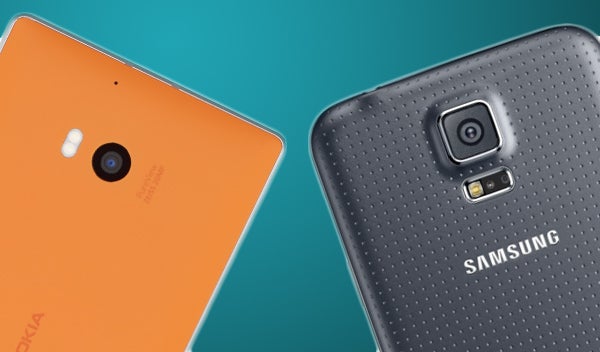
Which has the better camera?
The Nokia Lumia 930 and Samsung Galaxy S5 are two of the best smartphone cameras you can get. Nokia has produced some of the most important phone cameras ever made, and with the Lumia 930 carrying the PureView seal of approval, we have big expectations.
But can it hope to better the Samsung Galaxy S5, a true powerhouse of phone photography? We’ve given the two a test drive to see which is really better in photographic terms.
Nokia Lumia 930 vs Galaxy S5: Which camera is easier to use?
We find the Samsung Galaxy S5 marginally easier to use than the Lumia 930 camera. All of Nokia’s higher-end phones suffer from the same problem – they use two camera apps.
You get the Windows Phone app and Nokia’s own camera app. Choice is good, but ultimately this is quite confusing when they appear similar enough to think you’ve just pressed the wrong button and ended up in the wrong part of the same app.
SEE ALSO: Best Windows Phone Round-up
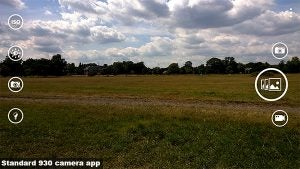
Samsung actually cut back its camera app for the Galaxy S5. Lots of the extra modes have been cut back to make it easier to use, and you can customise the interface to put the modes you need at your fingertips. You can also do this in the Lumia 930’s standard camera app, but it is a little fiddlier to do.
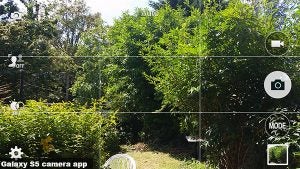
Nokia Lumia 930 vs Galaxy S5: Which gives more manual control?
However, for those really wanting to learn about photography from their phone, the Lumia 930 is much, much better. While having two camera apps isn’t great for beginners, the control the Nokia Camera app gives you is fantastic.
It goes over and above what you get from most other camera apps, letting you focus manually and set the shutter speed as well as fiddling with standard things like ISO and exposure compensation. With a bit of effort and know-how, you can get some creative results.
The only thing you can’t control is aperture, because the Nokia Lumia 930 aperture is fixed at f2.4.
SEE ALSO: Samsung Galaxy S5 vs Galaxy S4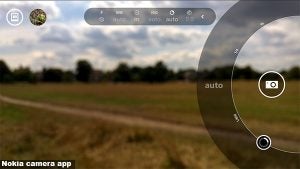
One of the best parts of the Lumia 930 is the control you get with the Nokia Camera app
The interface is neat too, using rotary sliders to let you change settings. Some Samsung cameras offer something similar, but it’s not available in the Galaxy S5.
The Samsung Galaxy S5 offers relatively little manual control. You can tweak ISO, exposure and so on, but shutter speed and focus are handled by the phone itself.
Nokia Lumia 930 vs Galaxy S5: Camera Specs and Performance
The Nokia Lumia 930 has a higher-resolution sensor than the Samsung Galaxy S5. It uses a 20.7-megapixel sensor while the Samsung Galaxy S5 has a 16-megapixel camera.
However, it’s all-too-easy to overemphasise this difference. The Nokia Lumia 930 has a 20.7-megapixel 1/2.5-inch camera sensor that predominantly deals with 5-megapixel photos.
Most of the information from the sensor is used, but it is boiled down to a 16:9 5-megapixel image to save space and reduce image noise. We saw a similar system in the Sony Xperia Z2, a 20.7-megapixel that largely outputs 8-megapixel photos.
You can force the Lumia 930 to save full-res photos too, but these are actually 16-megapixel shots in actuality as the phone shoots in 16:9 while having a 4:3 sensor. You can’t readily access them from the phone either.
The Lumia 930 is not what it at first appears to be.
We also found that the Galaxy S5 is faster to shoot with than the Lumia 930. Shot-to-shot speeds are slower and focusing is marginally slower at times. This may be in part down to the processing required in downscaling images to 5-megapixel format – it’s something we also saw in the Lumia 1020, and to a much greater extent.
The Galaxy S5 is helped on this front by its phase detection focusing, which stops the forward-back seeking that is used by the contrast detection system of the Lumia 930.
On the lens side, the Galaxy S5 is a bit faster, with an f-stop rating of f2.0 to the Lumia 930’s f2.4. Nokia uses a larger sensor to compensate for this actually relatively slow (among phones) lens, though.
Nokia Lumia 930 vs Galaxy S5: Detail and Exposure
In daylight, the Nokia Lumia 930 and Galaxy S5 are both accomplished photo takers. Colours are lively and well-saturated, exposure metering is fairly good and you can instantly tell the photos are from a good phone camera.
In common with other Lumia phones we’ve tried, the Lumia 930 has a slightly warm tone that gives shots a pleasant look. It could be seen as a deliberate stylisation, but it’s a minor one at best and it often leads to the Lumia photos looking a bit prettier than those of the Galaxy S5.
Where the Galaxy S5 excels is contrast and punchiness. Zoom into shots and you can see the difference in detail you get from a 16-megapixel S5 shot compared to a 5-megapixel 930 one. It’s big.
While you get far more fine detail with the Lumia 930 than you would from a ‘native’ 5-megapixel phone camera right down to pixel level, the Galaxy S5 gets you much more straight off the bat. This is improved if you dig out the full-resolution 16-megapixel Lumia shots, but let’s not forget that 5-megapixel shots are the Lumia 930’s real currency.
SEE ALSO: Best Smartphones Round-up


Here we see the detail you lose in the Lumia’s downgrading of images to 5MP. The Galaxy S5 shot also offers higher contrast.
Nokia Lumia 930 vs Galaxy S5: Macro
Get closer up to the subject and, once again, the phones perform well. The Samsung Galaxy S5’s clearer highlights bring out fine details in our macro subject below a bit more.
We also found that we were able to get a bit closer to the subject with the Galaxy S5, thanks to its slightly longer focal length. Where the Lumia 930’s lens has an equivalent focal length of 26mm, the Galaxy S5 has a 31mm-equivalent lens. That’s pretty ‘zoomed in’ for a phone, whose focal lengths tend to stay around the 26-28mm mark.
Phone makers try and sell wide angle lenses as a good thing, but for the kind of street-style photography most people do with their phones, something around the 35mm mark would actually be much better. You heard it here first, people.
For pure quality, we think the Galaxy S5 pips the Lumia 930 here, but they both do extremely well.
SEE ALSO: Samsung Galaxy S5 Tips, Tricks and Secrets
The Galaxy S5 let us get close up enough to see the top of flower go a little out of focus, due it exceeding the camera’s depth of field

Crisp and colourful, the Lumia 930 can take some lovely-looking close-ups
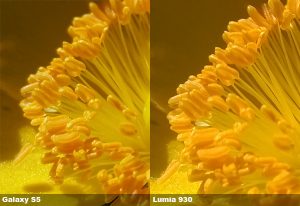
However, the Lumia 930 has real usability win too. More experienced photographers will love being able to use the manual focus of the Nokia Camera app to take macro shots.
Our macro example was pretty easy to shoot as the subject takes up most of the frame, but it would be far more difficult if the subject was much smaller – in this case phone invariably try to focus on the background, even if there is a macro focusing mode. For actually taking around town for macro photography, we’d probably pick the Lumia 930 as a result.
Nokia Lumia 930 vs Galaxy S5: HDR
HDR is an essential tool for the mobile photographer. It makes taking photos with light sources in the shot possible, and will sort out exposure issues in cloudy skies.
The Samsung Galaxy S5 has a dedicated HDR mode, but HDR has never been a big feature in Nokia phones. What you get instead in the Lumia 930 is a Backlight scene mode, which is the closest thing the Lumia 930 has to a real HDR mode.
But how to they compare? This is the area in which the Galaxy S5 puts the most distance between itself and the Lumia 930. The Galaxy S5 HDR mode is much, much better.
SEE ALSO: iPhone 6 release date, news, rumours, specs and price
The foreground appears underexposed as the Galaxy S5 tries to juggle between the super-bright sky and the other parts of the image. It hasn’t done too bad here without HDR, though.

Switch on HDR and there’s a complete change. The foreground is properly exposed, and only the area right around the sun appears overexposed. That there isn’t a particularly pronounced halo around objects is frankly amazing. Samsung is king of HDR.

While the foreground is reasonably clear, the sky is massively overexposed here. Part of the tree is obliterated. It’s probably better than ending up with a massively underexposed foregound, though.

The backlight mode has helped with the exposure of the sky, but the foreground is actually less well-exposed an there’s a weird yellow cast to it now too. It’s not a patch on the Samsung HDR mode.
One extra quick comparison:
There’s a nice ‘larger than life’ quality to this HDR shot, but it’s not enough to blast the photo into pure fantasy-land stuff

The backlight mode doesn’t do nearly as well. The sky is overexposed, the foreground is pretty glum, and again we get that yellowy colour cast.
Nokia Lumia 930 vs Galaxy S5: Shallow depth of field/bokeh
One way photographers make portraits pop is to use a wide lens aperture to produce a shallow depth of field effect, where the background appears blurry, making the subject pop all the more. Phone makers have tried to create this artificially in their latest phones, but how are the Galaxy S5 and Lumia 930 when producing a natural bokeh effect?
The Lumia 930 is a tiny bit better here, producing slightly more background blur. It is a little jittery compared to the Galaxy S5, but in mobile phones we’re happy for any effect, regardless of its character.
To get a significantly better shallow depth of field effect, you’d have to upgrade to the Lumia 1020, which we find to have more-or-less the best in this respect among ‘normal’ phones.
SEE ALSO: Windows 9 release date, preview and Start Menu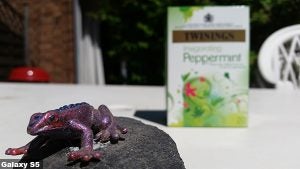
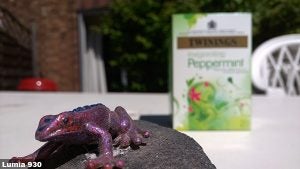
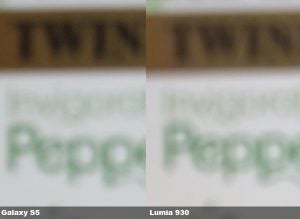
Blurring levels are very similar, but the Lumia 930 effect is marginally more pronounced
Nokia Lumia 930 vs Galaxy S5: Low-light Performance
What about low-light? This is traditionally the area in which phones really start to struggle. The Galaxy S5 and Lumia 930 tackle the problem rather differently.
Where the Lumia 930 has a dedicated Night scene mode, the Galaxy S5 instead uses something called picture stabilisation. It’s basically a simulated software form of optical image stabilisation that appears to involve stitching together numerous exposures in order to reduce noise and ramp-up detail. It takes a little longer as a result.
If you shoot with both phones in Auto, with the Galaxy S5’s stabilisation turned on, the Galaxy S5’s results are better. There’s less noise and loads more contrast, although dynamic range is a big issue. Check out the tree in the image below, which has been reduced to a flat black mass where there’s a bit more retained detail in the Lumia 930 shot.
SEE ALSO: Best Android Phones 2014 Round-up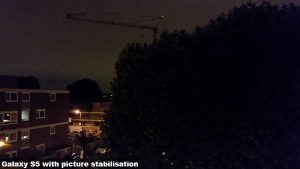
It’s dark but contrast is – as usual with the Galaxy S5 – great. If only there was a bit more shadow detail
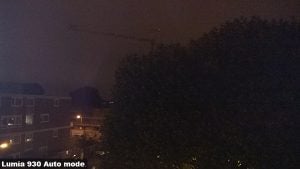
The Lumia 930 Auto photo is less contrasty, but there’s a smidge more shadow detail
Turn on the Lumia 930’s mode Night mode and it all changes. Like the
Sony Xperia Z2, the Lumia 930 is very effective at making do with barely
any light at all. Colour fidelity isn’t too bad considering what the
phone has to work with too – the lamp light is roughly on the money and
the tree is suitably green.
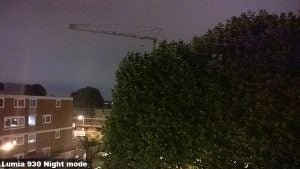
Boom – switch on night mmode and suddenly the scene is 400 per cent clearer. It looks more like dusk than night now, but sometimes clarity is all you’re after.
In terms of a picture you’d actually want to use and share, the Lumia 930 Night mode is the clear winner, and it’s quicker to shoot with than the Galaxy S5’s stabilisation mode.
Actually zoom in and look at the photos critically, though, and you will see that the Galaxy S5 actually produces a load more detail. As near-unusable as the photo is as a whole, you can read the phone number pasted on the side of the van in the background. That’s good going.
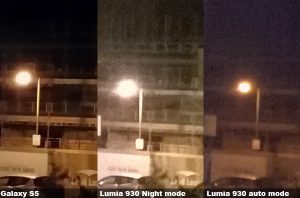
The Lumia 930 wins the night mode challenge, but the Galaxy S5 once again captures more detail
What about the flash? We try to avoid using the flash unless taking face-on portraits of people in very poor lighting, but it is useful at times. Both phones have an LED flash, but the Nokia Lumia 930 has a dual-LED one where the Galaxy S5 uses a single LED.
You might think that this would make the Lumia 930 much more powerful, but we found the Galaxy S5 to be a bit more powerful. However, the Lumia creates less harsh shadows and tends to blow out images a bit less.
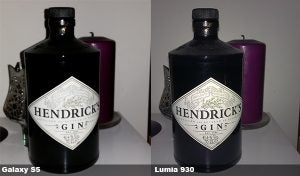
Which camera is right for you?
There are no bad choices here. The Galaxy S5 and Lumia 930 both have good cameras. However, for the average point ’n’ shoot mobile photographer, we think better results will come from the Galaxy S5.
Its borderline-magic HDR mode, the simpler approach to the interface and the faster shooting times are all big wins. However, if you want to use your phone to find out more about photography, it’s all about the Lumia 930. The Nokia Camera app lets you take a much more hands-on approach to your photos that shouldn’t be undervalued.
Next, read everything you need to know about the Samsung Galaxy S6


